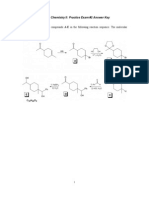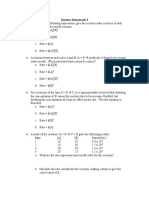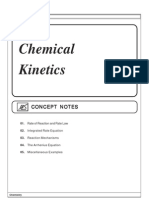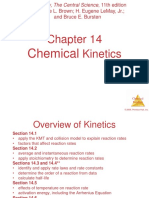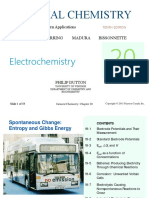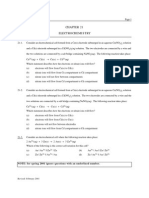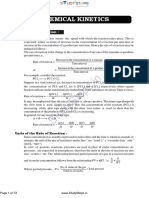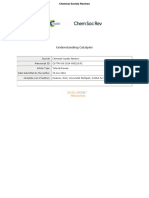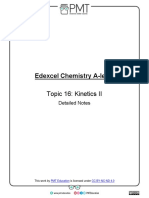KINETICS Practice Problems and Solutions
KINETICS Practice Problems and Solutions
Uploaded by
nairdanipsoCopyright:
Available Formats
KINETICS Practice Problems and Solutions
KINETICS Practice Problems and Solutions
Uploaded by
nairdanipsoOriginal Title
Copyright
Available Formats
Share this document
Did you find this document useful?
Is this content inappropriate?
Copyright:
Available Formats
KINETICS Practice Problems and Solutions
KINETICS Practice Problems and Solutions
Uploaded by
nairdanipsoCopyright:
Available Formats
KINETICS Practice Problems and Solutions
Name: AP Chemistry
Period: Date: Dr. Mandes
The following questions represent potential types of quiz questions. Please answer each question completely and
thoroughly. The solutions will be posted on-line on Monday.
5. Please do #18 in chapter 12 of your text.
a. This increases the [H
2
], which will increase the rate, but has no effect on k
b. Due to Arrhenius equation, changing temperature changes the value of k.
c. Catalyst function by lowering the activation energy, so due to Arrhenius equation, changing the activation energy
changes the value of k.
6. Consider the reaction: P
4
+ 6 H
2
4 PH
3
. A rate study of this reaction was conducted at 298 K. The
data that were obtained are shown in the table.
[P
4
], mol/L [H
2
], mol/L Initial Rate, mol/(L
.
s)
0.0110 0.0075 3.20 x 10
-4
0.0110 0.0150 6.40 x 10
-4
0.0220 0.0150 6.39 x 10
-4
a. What is the order with respect to: P
4
__0___.
H
2
__1___.
b. Write the rate law for this reaction. rate = k[H
2
]
c. Determine the value and units of the rate constant, k. plug and chug using the rate law & data from expt 1 and
solving for k, we get k = 0.0427 s
-1
7. Consider the reaction: SO
2
+ O
3
SO
3
+ O
2
. A rate study of this reaction was conducted at 298 K. The
data that were obtained are shown in the table.
[SO
2
], mol/L [O
3
], mol/L Initial Rate, mol/(L
.
s)
0.25 0.40
0.118
0.25 0.20
0.118
0.75 0.20
1.062
a. What is the order with respect to: SO
2
___2__.
O
3
___0__.
b. Write the rate law for this reaction. rate = k[SO
2
]
2
[O
3
]
0
c. Determine the value and units of the rate constant, k. plug and chug using the rate law & data from expt 1 and
solving for k, we get k = 2.36 mol
.
L
-1.
s
-1
8. Consider the following mechanism. A
2
+ B
2
R + C (slow)
A
2
+ R C (fast)
a. Write the overall balanced chemical equation. 2 A
2
+ B
2
2 C
b. Identify any intermediates within the mechanism. R
c. What is the order with respect to each reactant? A
2
1
st
; B
2
1
st
KINETICS Practice Problems and Solutions
d. Write the rate law for the overall reaction. rate = k [A
2
][B
2
]
9. Consider the following mechanism. O
3
O
2
+ O (fast)
O
3
+ O 2 O
2
(slow)
a. Write the overall balanced chemical equation. 2 O
3
3 O
2
b. Identify any intermediates within the mechanism. O
c. What is the order with respect to each reactant? O
3
2
nd
(once in rds, then once when sub for intermediate)
d. Write the rate law for the overall reaction. rate = k [O
3
]
2
10. Consider the reaction: 2B C + 3D. In one experiment it was found that at 300 K the rate constant is 0.134
L/(mol
.
s). A second experiment showed that at 450 K, the rate constant was 0.569 L/(mol
.
s). Determine the activation
energy for the reaction.
at 300 K:
300
Ea
RT
k Ae
at 450 K:
450
Ea
RT
k Ae
450
450
300 300 450
450 300
450 300
1 1
ln
ln( ) ln( ) ln( ) ln( )
ln( ) [ln( ) ]
ln( ) ( )
a
a a
a a
a
k E
A RT
E E
RT RT
E E
RT RT
k E
k R T T
k A where A k
so that
k k
plug and solve for Ea, Ea = 10.8 kJ
MORE PROBLEMS>>>>
Determining rate law from mechanisms (use the rate-determining step to get the orders).
1. One method for the destruction of ozone in the upper atmosphere is:
O
3
+ NO NO
2
+ O
2
(slow)
NO
2
+ O NO + O
2
(fast)
overall rxn O
3
+ O 2O
2
a. Which species is an intermediate?
b. Which species is a catalyst?
c. Which is the rate-determining step (rds)?
d. Number of times each reactant is used in the rds?
e. Write the rate law for the reaction.
KINETICS Practice Problems and Solutions
Determining rate law from Initial Rates. (Use the ratio of initial rates to get the orders).
2. Consider the table of initial rates for the reaction: 2ClO
2
+ 2OH
1-
ClO
3
1-
+ ClO
2
1-
+ H
2
O.
Experiment [ClO
2
]
o
, mol/L [OH
1-
]
o
, mol/L Initial Rate, mol/(L
.
s)
1 0.050 0.100
5.75 x 10
-2
2 0.100 0.100
2.30 x 10
-1
3 0.100 0. 050
1.15 x 10
-1
a . Order with respect to ClO
2
:
b. Order with respect to OH
1-
:
c. Rate law for this reaction:
d. Value and units for the rate constant:
3. Consider the table of initial rate for the reaction between hemoglobin (Hb) and carbon monoxide.
Experiment [HB]
o
, mol/L [CO]
o
, mol/L Initial Rate, mol/(L
.
s)
1 2.21 1.00
0.619
2 4.42 1.00
1.24
3 3.36 2.40
2.26
a . Order with respect to HB:
b. Order with respect to CO:
c. Rate law for this reaction:
d. Value and units for the rate constant:
Part II Select Response Select the best answer to each question.
1. If the reaction: 2HI 2H
2
+ I
2
HI is first order, which of the following will yield a linear plot?
a. log [HI] vs time b. 1/[HI] vs time e. [HI]
2
vs time
c. [HI] vs time d. ln[HI] vs time
2. Consider the reaction: X Y + Z. Which of the following is a possible rate law for the reaction?
a. rate = k[X] b. rate = k[Y][Z] e. rate = k[Z]
c. rate = k[Y] d. rate = k[X][Y]
3. Consider the rate law: rate = k[Y]
m
[Z]
n
. How are the exponents m and n determined?
a. by using the balanced chemical equation
b. by using the subscripts of the chemical formulas
c. by using the coefficients of the chemical formulas
d. by educated guess
e. by experiment
4. The following data were obtained for the reaction of NO with O
2
.
[NO]
o
[O
2
]
o
Initial Rate
1 x 10
18
1 x 10
18
2.0 x 10
18
2 x 10
18
1 x 10
18
8.0 x 10
18
KINETICS Practice Problems and Solutions
3 x 10
18
1 x 10
18
18.0 x 10
18
1 x 10
18
2 x 10
18
4.0 x 10
18
1 x 10
18
3 x 10
18
6..0 x 10
18
Which of the following is the correct rate law?
a. rate = k[NO][O
2
] b. rate = k[NO][O
2
]
2
e. rate = k[NO]
2
[O
2
]
2
c. rate = k[NO]
2
[O
2
] d. rate = k[NO]
2
5. If the reaction 2HI H
2
+ I
2
is second order, which of the following will yield a linear plot?
a. log [HI] vs time b. 1/[HI] vs time e. [HI]
2
vs time
c. [HI] vs time d. ln[HI] vs time
6. Which of the following statements is typically true for a catalyst?
a. The concentration of the catalyst will go down as the reaction proceeds.
b. The catalyst provides a new pathway in the reaction mechanism.
c. The catalyst speeds up the reaction.
d. Two of the above.
e. None of the above.
7. The catalyzed reaction has a _____ activation energy and thus causes a _____ reaction rate.
a. higher, lower b. higher, higher e. higher, steady
c. lower, higher d. lower, steady
KINETICS Practice Problems and Solutions
Part II Constructed Response Thoroughly and completely answer each question on a separate piece of paper.
8. Consider the exothermic reaction between reactants A and B?
A + B E (fast)
E + B C + D (slow)
a. What is the order with respect to reactants A and B? 1, 2
b. What is the rate law for the reaction?
c. Sketch a potential energy diagram for this reaction. Identify the activation energy for the overall forward
reaction. Identify the location of reactants, intermediate(s), activated complex(es), and products.
9. A first-order reaction is 38.5% complete in 480 s.
a. Calculate the value of the rate constant.
b. What is the value of the half-life.
c. How long will it take for the reaction to reach 95% completion.
10. The rate of the reaction NO
2
+ CO NO + CO
2
depends only on the concentration of nitrogen dioxide.
The following data were collected.
time, (s) [NO
2
]
o
, (M)
0 0.500
1.20 x 10
3
0.444
3.00 x 10
3
0.381
4.50 x 10
3
0.340
9.00 x 10
3
0.250
1.80 x 10
4
0.174
a. Determine the rate law.
b. Write the integrated rate law.
c. Determine the value of the rate constant for the reaction.
d. Calculate the [NO
2
] at 2.40 x 10
4
s after the start of the reaction.
KINETICS Practice Problems and Solutions
Determining rate law from time and concentration data. (Use the integrated rate laws and graphing to get orders).
4. The rate of this rxn depends only on NO
2
: NO
2
+ CO NO
+ CO
2
.
The following data were collected.
a. Order with respect to NO
2
:
b. Rate law for this reaction:
c. [NO
2
] at 2.7 x 10
4
s after the start of the rxn.
5. The following data were obtained for the decomposition of N
2
O
5
in CCl
4
.
The following data were collected.
a. Order with respect to N
2
O
5
:
b. Rate law for this reaction:
c. [N
2
O
5
] at 3.5 x 10
3
s after the start of the rxn.
SOLUTIONS!!!!!! TO MORE PROBLEMS>>>>>
1. a. Which species is an intermediate? NO
2
b. Which species is a catalyst? NO
c. Which is the rate-determining step (rds)? slow step
d. Number of times each reactant is used in the rds? O
3
is used once so order is 1
O is used zero times, so order is 0
e. Write the rate law for the reaction. rate = k[O
3
]
1
________________________________________________________________________________________________
Time (s) [NO
2
] (mol/L)
0 0.500
1200. 0.444
3000. 0.381
4500. 0.340
9000. 0.250
18000. 0.174
Time (s) [N
2
O
5
] (mol/L)
0 1.46
423 1.09
753 0.89
1116 0.72
1582 0.54
1986 0.43
2343 0.35
KINETICS Practice Problems and Solutions
Note that for a free-response question you must show the work (ratio of rate laws), but not for multiple choice
2.
2 2 2 2
1 2 1 1
[ ] [ ]
[ ] [ ]
m n
m n
rate k ClO OH
rate k ClO OH
2 2 2 2
3 2 3 3
[ ] [ ]
[ ] [ ]
m n
m n
rate k ClO OH
rate k ClO OH
0.230 0.100
0.0575 0.0500
m
m
0.230 0.100
0.115 0.0500
m
m
4 2
m
2 2
n
2 = m, so order is 2 1 = n, so order is 1
a. Order with respect to ClO
2
: 2
b. Order with respect to OH
1-
: 1
c. Rate law for this reaction: so, rate = k[ClO
2
]
2
[OH
1-
]
1
d. Value and units for the rate constant: k = 230
s mol
L
2
2
get the value by subbing the data for expt 1 into the rate law and solving for k
________________________________________________________________________________________________
3.
2 2 2
1 1 1
[ ] [ ]
[ ] [ ]
m n
m n
rate k HB CO
rate k HB CO
3 3 3
1 1 1
[ ] [ ]
[ ] [ ]
m n
m n
rate k HB CO
rate k HB CO
1.24 4.42
0.619 2.21
m
m
s
1
1
3.36 2.41
2.26
0.619
2.21 1.00
n
n
2 2
m
2.4 2.4
n
1 = m, so the order is 1 1 = n, so the order is 1
a. Order with respect to HB: 1
b. Order with respect to CO: 1
c. Rate law for this reaction: so, rate = k[HB]
1
[CO]
1
d. Value and units for the rate constant: k = 0.28
s mol
L
get the value by subbing the data for expt 1 into the rate law and solving for k
________________________________________________________________________________________________
KINETICS Practice Problems and Solutions
4.
Graph for zeroeth order: [NO
2
] vs. time [y vs. x; y = ax +b]
slope = -1.72 x 10
-5
y-intercept = 0.451 r
2
= 0.901
General integrated rate law: [A] = -kt + [A]o
This reaction's integrated rate law: [H
2
O
2
] = (-1.72 x 10
-5
)t + 0.451 r
2
= 0.901
Graph for first order: n[NO
2
] vs. time [y vs. x; y = ax +b]
slope = -5.78 x 10
-5
y-intercept = -0.770 r
2
= 0.971
General integrated rate law: n[A] = -kt + n[A]
o
This reaction's integrated rate law: n [NO
2
] = (-5.78 x 10
-5)
t + (-0.770) r
2
= 0.971
Graph for second order: [NO
2
]
-1
vs. time [y vs. x; y = ax +b]
slope = 2.10 x 10
-4
y-intercept = 2.01 r
2
= 0.999 - best so
order is 2
General integrated rate law:
1
] [ A = kt +
1
] [
o
A
This reaction's integrated rate law: [NO
2
]
-1
= 2.10 x 10
-4
t + 2.01 r
2
= 0.999
Graph with the greatest r
2
value: [NO
2
]
-1
vs. time, so the order is second order
a. Order with respect to NO
2
: 2
b. Rate law for this reaction: rate = k[NO
2
]
2
c. [NO
2
] at 2.7 x 10
4
s after the start of the rxn. Subbing 2.7 x 10
4
s for time in [NO
2
]
-1
= 2.10 x 10
-4
t
+ 2.01
[NO
2
] = 0.130 mol/L
_____________________________________________________________________________________________
5.
Graph for zeroeth order: [N
2
O
5
] vs. time [y vs. x; y = ax +b]
slope = -4.54 x 10
-4
y-intercept = 1.31 r
2
= 0.947
General integrated rate law: [A] = -kt + [A]o
This reaction's integrated rate law: [N
2
O
5
] = (-4.54 x 10
-4
)t + 1.31 r
2
= 0.947
Graph for first order: n[N
2
O
5
] vs. time [y vs. x; y = ax +b]
slope = -6.05 x 10
-4
y-intercept = 0..353 r
2
= 0.999
General integrated rate law: n[A] = -kt + n[A]
o
This reaction's integrated rate law: n[ N
2
O
5
] = (-6.05 x 10
-4)
t + 0.353 r
2
= 0.999 - best so
order is 1
KINETICS Practice Problems and Solutions
Graph for second order: [N
2
O
5
]
-1
vs. time [y vs. x; y = ax +b]
slope = 9.18 x 10
-4
y-intercept = 0.517 r
2
= 0.971s
General integrated rate law:
1
] [ A = kt - +
1
] [
o
A
This reaction's integrated rate law: [N
2
O
5
]
-1
= 9.18 x 10
-4
t + 0.517 r
2
= 0.971
Graph with the greatest r
2
value: n [N
2
O
5
] vs. time, so the order is first order
Order with respect to N
2
O
5
:
Rate law for this reaction:
a. Order with respect to N
2
O
5
: 1
b. Rate law for this reaction: rate = k[N
2
O
5
]
1
c. [N
2
O
5
] at 3.5 x 10
3
s after the start of the rxn. Subbing 3.5 x 10
3
s for time in n[ N
2
O
5
] = (-6.05 x 10
-
4)
t + 1.31
[N
2
O
5
] = 0.171 mol/L
You might also like
- Organic Chemistry II Practice Exam #2 Answer KeyDocument7 pagesOrganic Chemistry II Practice Exam #2 Answer KeyQuang Hiep HaNo ratings yet
- Adam1992 Hypochlorous Acid Decomposition in The PH 5-8 RegionDocument8 pagesAdam1992 Hypochlorous Acid Decomposition in The PH 5-8 RegionGregorio ValeroNo ratings yet
- LMS Solutions KineticsDocument295 pagesLMS Solutions KineticsCarlos Torres Echeverría50% (4)
- PMR Spectroscopy: Solved Problems Volume : IIFrom EverandPMR Spectroscopy: Solved Problems Volume : IIRating: 5 out of 5 stars5/5 (3)
- Chapter 8Document31 pagesChapter 8helloblarg100% (4)
- Chemistry 126 Test AnswersDocument7 pagesChemistry 126 Test AnswersEzequiel OrellanaNo ratings yet
- Rate of Chemical ChangesDocument3 pagesRate of Chemical ChangesAhmad Taufiq Mohd ZaidNo ratings yet
- Kinetics Homework 3Document4 pagesKinetics Homework 3RizkiNo ratings yet
- ArticleDocument12 pagesArticleASimilatrixNo ratings yet
- 11 Reaction KineticsDocument95 pages11 Reaction KineticsSyamil Adzman100% (1)
- Problem Set 1Document8 pagesProblem Set 1Bj LarracasNo ratings yet
- 102 MSJC 13Document11 pages102 MSJC 13noelNo ratings yet
- 14 EquilibriumDocument6 pages14 EquilibriumAgam HanasichulaNo ratings yet
- Worksheet-Arrhenius EquationDocument3 pagesWorksheet-Arrhenius EquationHaren Aizhel Tendero100% (1)
- Chemical Kinetics Part - IDocument43 pagesChemical Kinetics Part - ISanskar BhattacharyaNo ratings yet
- Chemical KineticsDocument169 pagesChemical KineticsHope World100% (1)
- Physical Chemistry ExamDocument5 pagesPhysical Chemistry ExamelnurorucluNo ratings yet
- Multiple Choice Exam Review - WITH ANSWERSDocument13 pagesMultiple Choice Exam Review - WITH ANSWERSgizeNo ratings yet
- Chemical Kinetics Problem SetDocument6 pagesChemical Kinetics Problem Setascd_msvuNo ratings yet
- Chap 8 Reaction Kinetics 1415FARRADocument129 pagesChap 8 Reaction Kinetics 1415FARRA黄麒安No ratings yet
- Chapter 7 ThermochemistryDocument43 pagesChapter 7 ThermochemistryGörkem Damdere100% (1)
- Chemical KineticsDocument50 pagesChemical KineticsMohammadHussainKhanNo ratings yet
- CHM111 - Chemical Equilibrium NoteDocument22 pagesCHM111 - Chemical Equilibrium NoteolufemisongNo ratings yet
- Chapter 10 Chemical Kinetics II PDFDocument130 pagesChapter 10 Chemical Kinetics II PDFJuanCarlosVazquezLira100% (3)
- Chapter 20 PetrucciDocument67 pagesChapter 20 PetrucciLoeyNo ratings yet
- CH 14-VP-Stoichiometry - 2020Document37 pagesCH 14-VP-Stoichiometry - 2020Mlamuli MlarhNo ratings yet
- Solved Multiple Choice Questions IE by NKB - PDF 116788864Document15 pagesSolved Multiple Choice Questions IE by NKB - PDF 116788864Pranav SharmaNo ratings yet
- CY 2301 Chemical Kinetics 1Document23 pagesCY 2301 Chemical Kinetics 1Pranay SahuNo ratings yet
- Problems ElectrochemistryDocument11 pagesProblems ElectrochemistryorlandompsilvaNo ratings yet
- Chapter 18 BANKDocument16 pagesChapter 18 BANKMeowCat123456789No ratings yet
- Formula Sheet PDFDocument5 pagesFormula Sheet PDFTech with GamesNo ratings yet
- Ch123 Exam II Practice Exam Spring2011Document7 pagesCh123 Exam II Practice Exam Spring2011christopher92530% (1)
- Chapter 6 TestDocument5 pagesChapter 6 TesthelloblargNo ratings yet
- Chapter 5 ExerciseDocument11 pagesChapter 5 ExerciseSuriaraj Krishnan100% (1)
- Kineticsss Notes PDFDocument73 pagesKineticsss Notes PDFArun SharmaNo ratings yet
- Chem 31 Prob Set Org Mech NucleophilicDocument3 pagesChem 31 Prob Set Org Mech NucleophilicJolaine ValloNo ratings yet
- Gibbs Homework SolutionsDocument16 pagesGibbs Homework SolutionsAbu Farhoud75% (4)
- Thermodynamic Property RelationsDocument26 pagesThermodynamic Property RelationsSec CNo ratings yet
- Chapter 6Document17 pagesChapter 6helloblarg100% (3)
- Gen Chem II Exam 2 Practice Problems f08Document8 pagesGen Chem II Exam 2 Practice Problems f08Nikka LopezNo ratings yet
- Topic 9 19 MC PracticeDocument18 pagesTopic 9 19 MC PracticeDharmesh Ramnarayan Yadav100% (1)
- Ch.6 PracticeQuestionsDocument19 pagesCh.6 PracticeQuestionsLiew Dong YeeNo ratings yet
- Question On Chemical Kinetics-MA 2022Document12 pagesQuestion On Chemical Kinetics-MA 2022Sangay ChodenNo ratings yet
- 316 Midterm ExamDocument3 pages316 Midterm ExamKhaled AbeedNo ratings yet
- 09 - Flinn - Stoichiometric Ratio of A ReactionDocument8 pages09 - Flinn - Stoichiometric Ratio of A ReactionDerek Hammons100% (1)
- Chemical Kinetics ExercisesDocument2 pagesChemical Kinetics ExercisesBanana CrazyNo ratings yet
- 5.chemical Equilibrium ExerciseDocument37 pages5.chemical Equilibrium ExerciseUday MehtaniNo ratings yet
- ElectrochemistryDocument87 pagesElectrochemistryMohit Agrawal50% (2)
- Test4 ch19 Electrochemistry Practice-answers-MarkedDocument13 pagesTest4 ch19 Electrochemistry Practice-answers-MarkedEga SukmaNo ratings yet
- Exam I - Rate Law ProblemsDocument26 pagesExam I - Rate Law ProblemsPeachYpeachasNo ratings yet
- Module 1 - Electrochemical EnergyDocument129 pagesModule 1 - Electrochemical EnergyknightruzelNo ratings yet
- Chemistry Gas Laws ExercisesDocument6 pagesChemistry Gas Laws Exercisesjag1231No ratings yet
- 201B Work 1 KineticsDocument9 pages201B Work 1 Kineticsahraz93No ratings yet
- Kinetics WKST KeyDocument5 pagesKinetics WKST KeyMikey MadRatNo ratings yet
- Big Idea 4 AnswersDocument4 pagesBig Idea 4 AnswersSreeyaNo ratings yet
- Advancedchemistry-Lecture Slides-Kinetics Lessons Student VersionDocument26 pagesAdvancedchemistry-Lecture Slides-Kinetics Lessons Student VersionJavier Blanco AlvarezNo ratings yet
- Tutorial Sheet On Chemical KineticsDocument5 pagesTutorial Sheet On Chemical Kineticstomarayush570No ratings yet
- Study Guide Unit 2Document8 pagesStudy Guide Unit 2AatishImrozNo ratings yet
- 2011-2012 Prequiz For Kinetics - Problems and SolutionsDocument7 pages2011-2012 Prequiz For Kinetics - Problems and SolutionsJomari GaliasNo ratings yet
- Unit One AnswersDocument11 pagesUnit One AnswersMarko MihokovićNo ratings yet
- Paper: Chemistry:: Chemistry MCQ: Chemical KineticsDocument10 pagesPaper: Chemistry:: Chemistry MCQ: Chemical KineticsShakeel AhmadNo ratings yet
- C CC CDocument9 pagesC CC CAkhil KhannaNo ratings yet
- 01 Palladium Catalyst ChenDocument354 pages01 Palladium Catalyst ChenNITINNo ratings yet
- Chemical KineticsDocument32 pagesChemical KineticsTimothy HandokoNo ratings yet
- Chemical KineticsDocument60 pagesChemical KineticsThe Rock75% (4)
- Deriving Rate Laws From Reaction Mechanisms Involving Equilibrium Elementary Steps With AnswersDocument5 pagesDeriving Rate Laws From Reaction Mechanisms Involving Equilibrium Elementary Steps With AnswersSukaran SinghNo ratings yet
- Chapter 10 for Students 增加生活小常識Document43 pagesChapter 10 for Students 增加生活小常識jessNo ratings yet
- Elucidation of Molybdenum Trioxide SulfurizationDocument7 pagesElucidation of Molybdenum Trioxide SulfurizationKaffe y AmigosNo ratings yet
- Understanding CatalysisDocument34 pagesUnderstanding Catalysisaisyahzafira26No ratings yet
- A2 20 QuestionsDocument15 pagesA2 20 Questions2hm8krdvz2No ratings yet
- CHE S402 Chapter5 Rate Equations For Fluid Solid Reactions Kinetic Modelspart3Document14 pagesCHE S402 Chapter5 Rate Equations For Fluid Solid Reactions Kinetic Modelspart3vagarious chandanNo ratings yet
- A2 Chemistry Reaction Kinetics Notes by Sir Muneeb Saleem +923219973304Document19 pagesA2 Chemistry Reaction Kinetics Notes by Sir Muneeb Saleem +923219973304Versha VasdaniNo ratings yet
- Chem Kinetics Ib QuestionsDocument26 pagesChem Kinetics Ib QuestionsDhruv KhuranaNo ratings yet
- CHEM271 - S13 Hour Exam IIIADocument4 pagesCHEM271 - S13 Hour Exam IIIAjohnbharot91No ratings yet
- Thermochemistry Unit ReviewDocument4 pagesThermochemistry Unit Review794586No ratings yet
- Alkyl Halides: Organic ChemistryDocument35 pagesAlkyl Halides: Organic ChemistryBlessy MartinNo ratings yet
- Suny Chemistryformajorsxmasterchapterreaction Mechanisms Missing FormulasDocument1 pageSuny Chemistryformajorsxmasterchapterreaction Mechanisms Missing Formulasavni jainNo ratings yet
- Unit 6.problem Set 2Document5 pagesUnit 6.problem Set 2Aryaa KapilNo ratings yet
- MSCCH 506Document176 pagesMSCCH 50620tamilselvi-ugcheNo ratings yet
- Detailed Notes - Topic 16 Kinetics II - Edexcel Chemistry A-LevelDocument10 pagesDetailed Notes - Topic 16 Kinetics II - Edexcel Chemistry A-LevelChowdr XPNo ratings yet
- 5.1.1 Rates of ReactionDocument91 pages5.1.1 Rates of ReactionAl BNo ratings yet
- Kinetics BookstaverDocument63 pagesKinetics BookstaverQuinnNo ratings yet
- Chemical KineticsDocument72 pagesChemical KineticsSiddhartha KumarNo ratings yet
- Flashcards - Topic 11 Kinetics - Edexcel IAL Chemistry A-LevelDocument69 pagesFlashcards - Topic 11 Kinetics - Edexcel IAL Chemistry A-LevelzuveriaNo ratings yet
- Chemical Kinetics: Rate of Reaction MechanismDocument60 pagesChemical Kinetics: Rate of Reaction MechanismAneudis Javier BritoNo ratings yet
- Xu and FromentDocument9 pagesXu and FromentJhimmy Terceros100% (1)
- Essentials of Chemical KineticsDocument49 pagesEssentials of Chemical KineticsJohn KanteNo ratings yet
- Deriving Rate Laws Using The Steady-State Approximation - Part IDocument4 pagesDeriving Rate Laws Using The Steady-State Approximation - Part IGürkan KarakaşNo ratings yet
- Aqa 1 5Document19 pagesAqa 1 5leonidas.wujieweiNo ratings yet
- Chemical KineticsDocument41 pagesChemical Kineticskishangopi1230% (1)
